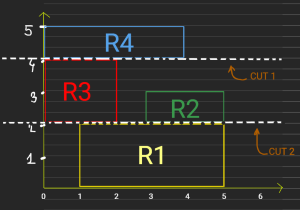Check if Grid can be Cut into Sections
Problem Description
You are given an integer n representing the dimensions of an n x n grid, with the origin at the bottom-left corner of the grid. You are also given a 2D array of coordinates rectangles, where rectangles[i] = [startx, starty, endx, endy] represents a rectangle on the grid. Each rectangle is defined as follows:
(startx, starty): The bottom-left corner of the rectangle.(endx, endy): The top-right corner of the rectangle.
Conditions to Satisfy:
Your task is to determine if it is possible to make either two horizontal or two vertical cuts on the grid such that:
- Each of the three resulting sections formed by the cuts contains at least one rectangle.
- Every rectangle belongs to exactly one section (i.e., no rectangle spans across a cut).
Return:
trueif such cuts can be made.falseotherwise.
Examples & Explanation
Example 1
Input:
n = 5
rectangles = [[1,0,5,2],[0,2,2,4],[3,2,5,3],[0,4,4,5]]
Grid Representation:

Explanation:
We can make horizontal cuts at y = 2 and y = 4, forming three sections:
- Section 1: Below
y = 2(containsR1) - Section 2: Between
y = 2andy = 4(containsR2andR3) - Section 3: Above
y = 4(containsR4)
Since all conditions are satisfied, output is true.
Constraints
Rectangles do not overlap.
Category:- Arrays
- Sorting
Programming Language: - Java
Reference Link:
https://leetcode.com/problems/check-if-grid-can-be-cut-into-sections/description/
Java
Output:
Loading component...
Loading component...